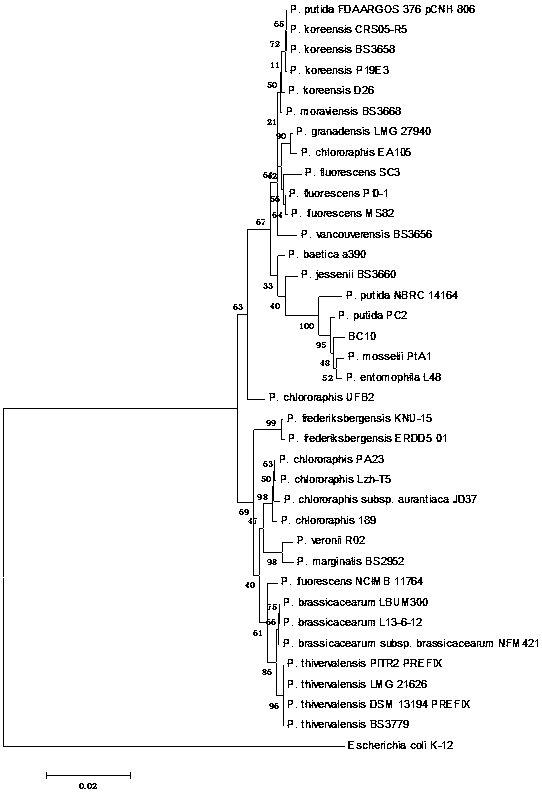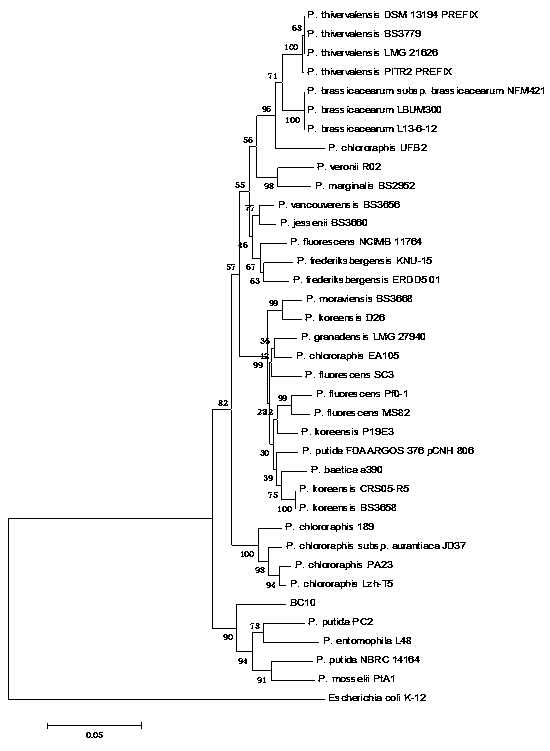Pseudomonas putida BC10 and application thereof in controlling bacterial soft rot of crops
A Pseudomonas putida and bacterial technology, which is applied to Pseudomonas putida BC10 and its application in preventing and controlling bacterial soft rot of crops, can solve problems such as toxicity, water resources pollution, bacterial resistance and the like, Achieve good inhibitory effect, good control effect, and reduce the occurrence of bacterial soft rot of crops
- Summary
- Abstract
- Description
- Claims
- Application Information
AI Technical Summary
Problems solved by technology
Method used
Image
Examples
Embodiment 1
[0035] Example 1 Isolation and screening of Pseudomonas putida BC10
[0036] 1. Strain isolation
[0037] (1) Sample collection: In the rhizosphere soil of cabbage in Dalingxia Village, Yashan Village Committee, Quzhang Township, Hepu Township, Guangxi, soil samples below 5 cm of the soil surface were excavated and stored in bags, and brought back to the laboratory for strain isolation.
[0038] (2) Isolation of bacterial strains: Soil samples were isolated by dilution coating plate method. Specifically, after the collected soil samples were thoroughly mixed by hand, 4.0 g was weighed, soaked in 20 mL of sterile water and shaken, and then cultured on a shaker at 28 °C and 180 rpm for 20 min for gradient dilution. Take the dilution factor as 10 5 ~10 9 100 µL of the diluted solution was spread on the LB plate, air-dried at room temperature, sealed, and incubated upside down in a 28°C incubator for 24 h. Pick a single colony grown on the LB plate, label it, place it in a 2 m...
Embodiment 2
[0041] Example 2 Identification of Pseudomonas putida BC10
[0042] 1. Morphological and physiological and biochemical identification
[0043] The colonies of BC10 on LB medium are round, milky white to yellowish, with smooth and neat edges, slightly raised in the middle, opaque, Gram stain negative, can liquefy gelatin, produce acid and catalase, but not amylase, Fructose can be used, trehalose can be used in a small amount, and galactose, mannitol, glucose and sucrose cannot be used.
[0044] 2. Molecular identification
[0045] In order to clarify the taxonomic status of the strain BC10 obtained in Example 1, the method of multilocus sequence analysis (MLSA) combined with phylogenetic analysis (Phylogenetic analysis) was used to identify the BC10 strain.
[0046] 16S rDNA sequence analysis is a molecular biological identification method for bacterial identification. The present invention analyzes the 16S rDNA sequence and combines the conservative housekeeping gene gyrB ,...
Embodiment 3
[0049] Example 3 Determination of Pseudomonas putida BC10 bacteriostatic spectrum
[0050] 1. Determination of antibacterial spectrum
[0051] In order to better study the biocontrol potential of the bacterial strain BC10 of the present invention, the antibacterial spectrum of the bacterial strain was studied. The specific operation is as follows:
[0052] (1) Explore whether BC10 has the ability to inhibit the growth of other pathogenic bacteria. Use the method identical with embodiment 1 bacterial strain screening, change pathogenic bacterium MS2 into the equal amount of rice base rot pathogen EC1, banana bacterial soft rot pathogen MS2 and MS3, bacterial wilt pathogen EP1 (first Layer 15 mL of LB into 15 mL of TTC), rice bacterial blight Xoo, rice soft rot fungus SC7 and peach rot fungus PP1, and the rest of the steps remain unchanged.
[0053] (2) To explore whether BC10 has the ability to inhibit the growth of pathogenic fungi. The fungi tested included capsicum anthr...
PUM
 Login to View More
Login to View More Abstract
Description
Claims
Application Information
 Login to View More
Login to View More - R&D
- Intellectual Property
- Life Sciences
- Materials
- Tech Scout
- Unparalleled Data Quality
- Higher Quality Content
- 60% Fewer Hallucinations
Browse by: Latest US Patents, China's latest patents, Technical Efficacy Thesaurus, Application Domain, Technology Topic, Popular Technical Reports.
© 2025 PatSnap. All rights reserved.Legal|Privacy policy|Modern Slavery Act Transparency Statement|Sitemap|About US| Contact US: help@patsnap.com



